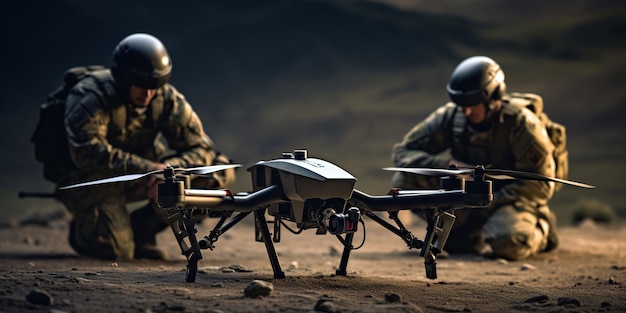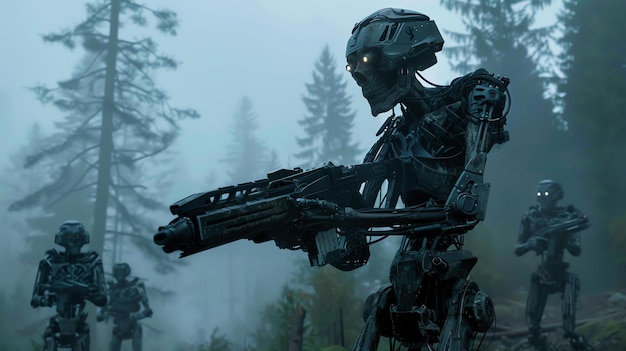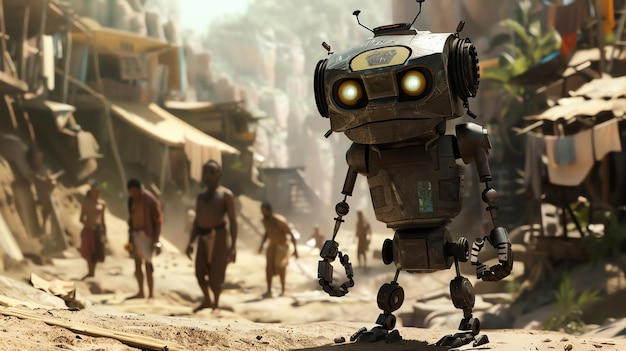Quick Read
Let Slip the Robot Dogs of War: A Deep Dive into the Future of Military Technolog
In the realm of military innovation, technology continues to push boundaries and redefine warfare. One fascinating aspect that is gaining traction is the integration of robotics into military operations, specifically in the form of robot dogs. These intelligent machines have immense potential and can significantly alter the face of warfare.
Background
The concept of using robots in warfare dates back to the 19th century when remote-controlled torpedoes were developed. However, it wasn’t until the late 20th and early 21st centuries that unmanned aerial vehicles (UAVs) and ground robots gained prominence. Robot dogs, also known as military service robots, represent the latest evolution of this trend.
Capabilities and Advantages
Robot dogs boast several advantages that make them indispensable in modern warfare. They can perform various tasks, such as reconnaissance, bomb detection, and even combat support. These machines are designed to be agile, with the ability to traverse diverse terrains, including rugged mountains, deep water, and urban environments. Moreover, they can work for extended periods without rest, reducing the need for human intervention.
Challenges and Ethical Concerns
While robot dogs offer numerous benefits, they also come with challenges. One significant issue is the ethical concern surrounding their use in warfare. Critics argue that these machines may dehumanize conflict and blur the lines between peace and war. Another challenge is the development of ai systems to control and coordinate robot dogs effectively, ensuring they do not malfunction or cause unintended consequences.
The Evolution and Significance of Military Technology: From Ancient Weapons to Robotic Warfare
Military technology, a critical component of human conflict and warfare throughout history, has undergone significant transformations from ancient times to the present day. Its development not only reflects advancements in science and engineering but also shapes political power dynamics and global security.
Ancient Warfare: Weapons and Tactics
Ancient warfare: The earliest military technology was characterized by simple yet effective weapons and tactics. Spears, shields, bows and arrows, and catapults were commonly used. The development of chariots provided a significant tactical advantage, enabling quick mobility and superior firepower in engagements.
Age of Gunpowder: Firepower and Fortifications
The advent of gunpowder in the Middle Ages marked a major turning point. Guns, cannons, and muskets revolutionized warfare. Fortifications became increasingly complex, with bastions and moats designed to protect against gunfire.
World War I: Trenches and Modern Technology
World War I introduced the era of trenches and chemical warfare. The use of machine guns, tanks, and airplanes transformed the battlefield. This period also saw significant progress in medical technology, leading to improved survival rates for wounded soldiers.
Cold War: Nuclear Weapons and Strategic Arms Race
The Cold War brought about the development of nuclear weapons. The arms race between the United States and the Soviet Union led to significant advancements in missile technology, radar systems, and satellite surveillance. The threat of mutual destruction forced both sides to develop strategic defense measures and disarmament negotiations.
Present Day Military Technology: The Transition to Robotic Warfare
Today’s military technology is characterized by advanced robotics and artificial intelligence. Drones, autonomous vehicles, and cyber warfare are becoming increasingly prevalent. The significance of this shift lies in the potential for reduced human casualties, increased efficiency and precision, and the ability to maintain a strategic advantage over adversaries.
The Evolution of Robotics in Military Applications
Early experiments with unmanned vehicles
The use of robotics in military applications began with early experiments in unmanned vehicles. In the realm of aerial reconnaissance, drones have emerged as a game-changer, offering unparalleled surveillance capabilities and reducing the risk to human life. The drones‘ ability to fly at high altitudes, cover vast territories, and remain airborne for extended periods has made them an indispensable tool for intelligence gathering. Similarly, in the terrain of unmanned ground vehicles (UGVs), these robots have demonstrated exceptional capabilities for hazardous missions such as mine clearance, bomb disposal, and reconnaissance.
The development of robotic soldiers
The next phase in the evolution of robotics for military applications brought about the concept of robotic soldiers. This advancement was primarily driven by significant funding and research from various military organizations worldwide. The convergence of AI, sensors, and advanced materials has allowed the creation of robots capable of autonomous decision making, adaptability to varying environments, and human-like mobility. These developments have opened up exciting possibilities for the military, including potential applications in reconnaissance, combat support, and even autonomous weaponry.
Ethical considerations and debates around robotic soldiers
As the development of robotic soldiers progresses, ethical considerations and debates have arisen. Questions around accountability, morality, and potential risks to civilians are at the forefront of these discussions. Some argue that robotic soldiers could reduce casualties among human troops and potentially save lives, while others fear the potential for unchecked military power and loss of human control. These debates continue to shape the future development and deployment of robotic soldiers in military applications.

I Current Applications of Military Robotics
Military robotics have transformed the battlefield by providing enhanced capabilities and reducing risks to human soldiers. This section explores various applications of military robotics in modern warfare.
Reconnaissance and Surveillance
Ground robotics: Ground robots, such as the Packbot and the Marathon robot, are used extensively for reconnaissance tasks. Equipped with cameras, microphones, and thermal sensors, these robots can detect and identify potential threats while providing real-time video feeds to military personnel. They are particularly useful in dangerous situations like IED detection and disposal.
Aerial drones: Aerial drones, like the Predator B and Reaper, are widely used for reconnaissance, surveillance, and targeted strikes. They can fly at high altitudes, cover vast areas, and stay in the air for extended periods. Their advanced sensors, such as electro-optical/infrared (EO/IR) systems and synthetic aperture radars (SAR), can detect and classify objects on the ground. Moreover, they can transmit real-time data to command centers, enabling rapid response to threats.
Maritime applications: Maritime robotics include unmanned surface vessels (USVs), underwater robots, and aerial drones used for maritime reconnaissance. USVs, such as the Sea Hunter and Wave Glider, can be used to monitor coastlines, detect submarines, and provide communication relay services. Underwater robots, like the Hugin and REMUS, are designed for mine countermeasures, environmental monitoring, and undersea exploration.
Bomb disposal and hazardous material handling
Robots are increasingly used for bomb disposal and hazardous material handling due to their ability to access dangerous areas without risking human lives. Robots like the QinetiQ’s Remotec Jackal and the iRobot Packbot are designed to detect and neutralize explosive devices, while robots like the TALON robot can handle hazardous materials like chemical spills.
Logistical support and transportation
Logistical support: Military robotics are used for logistical tasks, such as cargo transport and resupply missions. Unmanned Ground Vehicles (UGVs) like the Mules and RMAX can carry heavy loads over long distances, reducing the need for human personnel. Drones can be used to transport supplies in hard-to-reach areas and even deliver medical aid.
Autonomous weapons systems
Landmines and unmanned aerial vehicles (UAVs) for targeted strikes: Autonomous weapons systems like landmines and UAVs can be used for targeted strikes against enemy forces. Landmines, such as the Sensor-Fused Weapon System (SFW), can detect and destroy vehicles based on their size, shape, and speed. UAVs, like the Predator B and Reaper, can conduct reconnaissance, identify targets, and launch missile strikes autonomously.
Swarm drones and autonomous underwater vehicles (AUVs): Swarm drones and AUVs are emerging technologies that can significantly enhance military capabilities. Swarm drones, like the Perdix and the Blackjack, can operate in large groups to overwhelm enemy defenses or perform complex tasks beyond human capabilities. AUVs, like the Bluefin-21 and HydroLab, can conduct long-duration missions underwater, mapping seafloor terrain, detecting mines, or even gathering intelligence.

Future Applications of Military Robotics
Autonomous Combat Units
Autonomous combat units represent the future of warfare technology, and their potential role is vast. These robots are designed to operate independently in dangerous environments, reducing the risk to human soldiers. Benefits include increased efficiency, decreased human casualties, and the ability to remain on the battlefield longer than humans. However, ethical concerns and potential risks cannot be ignored. Autonomous units raise questions about accountability for actions taken, the possibility of malfunctions leading to unintended consequences, and the impact on the military-industrial complex.
Advanced Sensor Technology
Another significant area of military robotics is advanced sensor technology. Robots equipped with thermal imaging and other advanced sensors can be used for reconnaissance, surveillance, and target acquisition. The applications are vast, from detecting enemy movements in dark or obscured environments to identifying potential threats from a distance.
Energy Harvesting and Self-Sustaining Robotics
Military robotics is also exploring the use of renewable energy sources such as solar power. This technology, known as “energy harvesting” and “self-sustaining robotics,” has the potential to reduce the need for fuel supply and logistics. This not only decreases costs but also reduces environmental impact and increases operational efficiency.
Human-Robot Collaboration
Finally, human-robot collaboration is an exciting area of development in military robotics. Advancements in AI and human-machine interaction are allowing for more sophisticated collaboration between soldiers and robots. Applications include military training, rehabilitation, and support roles. The benefits of this technology include increased efficiency, improved safety, and the potential for enhanced military capabilities.

Conclusion
Military robotics have made significant strides in recent years, transforming the battlefield and modern warfare in numerous ways. Current applications, such as unmanned aerial vehicles (UAVs), ground robots, and underwater drones, have proven invaluable for reconnaissance, surveillance, bomb disposal, and even combat missions. These technologies enable military forces to operate more effectively and efficiently, reducing risks to human lives and minimizing collateral damage.
Future trends and potential developments
As military robotics continue to advance, we can expect even more sophisticated systems with greater autonomy, agility, and lethality. Advanced artificial intelligence and machine learning algorithms will enable robots to make decisions independently in complex environments, further enhancing their utility for military operations. Additionally, nanorobotics, swarm robotics, and robots integrated with advanced sensors and communications networks will expand their capabilities to new dimensions.
Ethical considerations and the role of society in regulating military robotics
As promising as military robotics are, they also raise significant ethical concerns. Balancing military advantage with ethical considerations is a crucial aspect of their development and deployment. While autonomous weapons offer the potential for increased precision and reduced collateral damage, they also challenge long-standing ethical norms around human involvement in warfare.
Balancing military advantage with ethical concerns
Ongoing debates
around autonomous weapons and human involvement in warfare have intensified as military robotics continue to advance. Some argue that autonomous weapons could lead to unintended consequences, such as targeting errors or escalating conflicts without human oversight. Others argue that retaining human control is essential to ensuring the ethical and legal constraints of armed conflict are respected.
Human involvement in warfare
The role of humans in military operations will continue to evolve as robotics and artificial intelligence become more advanced. While some see this as an opportunity for soldiers to focus on higher-level tasks, others fear that humans may be increasingly removed from the frontlines and lose their connection to the realities of war.
Final thoughts on the impact of military robotics on the future of warfare and society as a whole
Military robotics will undoubtedly shape the future of warfare in profound ways, from reducing human casualties to transforming the nature of military conflict. However, it is essential that we remain cognizant of their ethical implications and work together as a society to establish guidelines and regulations that ensure they are used responsibly.
Conclusion
In conclusion, military robotics offer a unique opportunity to improve the effectiveness and efficiency of military operations while reducing risks to human lives. However, their development and deployment must be guided by ethical considerations and societal values that prioritize the protection of human life and dignity. As we navigate this complex landscape, it is crucial to engage in an open and inclusive dialogue about the role of military robotics in our future.
